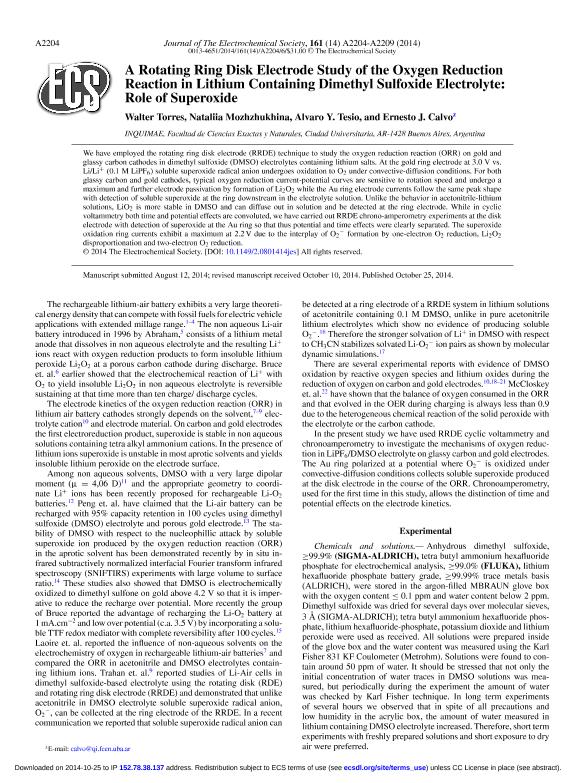Artículo
A Rotating Ring Disk Electrode Study of the Oxygen Reduction Reaction in Lithium Containing Dimethyl Sulfoxide Electrolyte: Role of Superoxide
Fecha de publicación:
10/2014
Editorial:
Electrochemical Society
Revista:
Journal of the Electrochemical Society
ISSN:
0013-4651
Idioma:
Inglés
Tipo de recurso:
Artículo publicado
Clasificación temática:
Resumen
We have employed the rotating ring disk electrode (RRDE) technique to study the oxygen reduction reaction (ORR) on gold and glassy carbon cathodes in dimethyl sulfoxide (DMSO) electrolytes containing lithium salts. At the gold ring electrode at 3.0 V vs. Li/Li+ (0.1 M LiPF6) soluble superoxide radical anion undergoes oxidation to O2 under convective-diffusion conditions. For both glassy carbon and gold cathodes, typical oxygen reduction current-potential curves are sensitive to rotation speed and undergo a maximum and further electrode passivation by formation of Li2O2 while the Au ring electrode currents follow the same peak shape with detection of soluble superoxide at the ring downstream in the electrolyte solution. Unlike the behavior in acetonitrile-lithium solutions, LiO2 is more stable in DMSO and can diffuse out in solution and be detected at the ring electrode. While in cyclic voltammetry both time and potential effects are convoluted, we have carried out RRDE chrono-amperometry experiments at the disk electrode with detection of superoxide at the Au ring so that thus potential and time effects were clearly separated. The superoxide oxidation ring currents exhibit a maximum at 2.2 V due to the interplay of O2− formation by one-electron O2 reduction, Li2O2 disproportionation and two-electron O2 reduction.
Palabras clave:
Rotating Ring Disk Electrode
,
Lithium Air Batteries
,
Superoxide
,
Dmso
Archivos asociados
Licencia
Identificadores
Colecciones
Articulos(INQUIMAE)
Articulos de INST.D/QUIM FIS D/L MATERIALES MEDIOAMB Y ENERGIA
Articulos de INST.D/QUIM FIS D/L MATERIALES MEDIOAMB Y ENERGIA
Articulos(SEDE CENTRAL)
Articulos de SEDE CENTRAL
Articulos de SEDE CENTRAL
Citación
Calvo, Ernesto Julio; Tesio, Alvaro Yamil; Mozhzhukhina, Nataliia; Torres, Walter Ramon; A Rotating Ring Disk Electrode Study of the Oxygen Reduction Reaction in Lithium Containing Dimethyl Sulfoxide Electrolyte: Role of Superoxide; Electrochemical Society; Journal of the Electrochemical Society; 161; 14; 10-2014; 2204-2209
Compartir
Altmétricas




